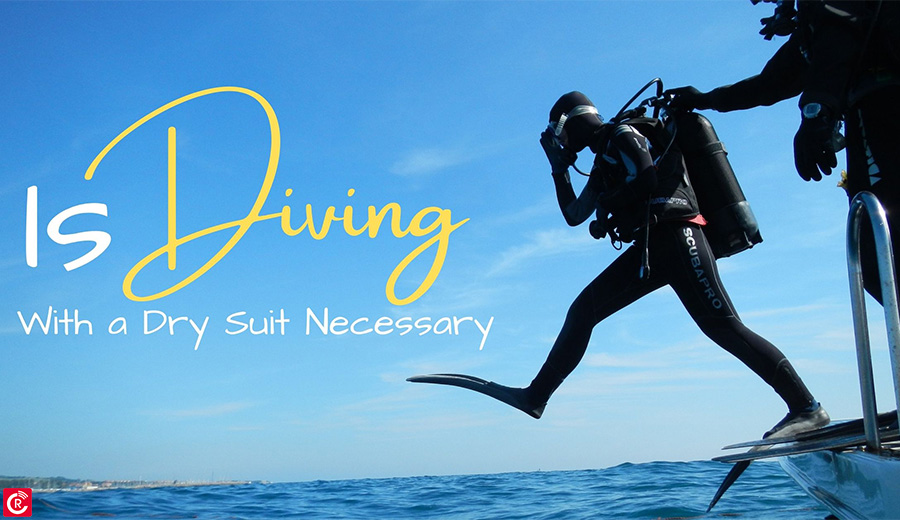
Who doesn’t like water? And diving has been one of the most engaging activities people adore. What many of us love about the ocean is that it is beautiful inside and out. Whether it is underwater or from the outside, the view is spectacular. There’s chaos, and there is peace at the same time. The seashore makes you feel like you are home, and the water soothes your soul and body. And no matter how cold the water might be, it’s always worth taking a chance and diving in.
But diving isn’t as simple as it sounds; the beauty is worth the pain, but why suffer when you have a lot of options to look forward to in the market. For example, many people find it easy to use a swimsuit instead of a dry suit, which is only because they do not know its importance.
Let’s start with the basics; what is a dry suit?
A dry suit is a suit, but it acts as a shield for a water sports enthusiast for a specific purpose. It is used mainly by those who play or work near cold water. It covers most body parts except the head, feet, and hands, although that can be covered with hazmat configurations.
Can’t we wear regular wetsuits?
Regular wetsuits are made of a kind of rubber which is known as neoprene. Surfers, swimmers, or divers wear this unique suite. Why is it known as a wetsuit? This is because the suit traps water between the wearer’s skin and the neoprene, which is why the wearer stays wet. Doesn’t the wearer feel cold if they are in close proximity to the water? Our body heat helps the water that is trapped to be warm, allowing the wearer to feel warm even when they are in the water.
A surfer or anyone who uses the wetsuit should remember that the suit must be closely fitted to their body. If it is loose, it gets difficult for the body to keep the water warm around it. These suits can be either those which cover the whole body or the ones which reach the knees. For further protection, most swimmers use hoods or jackets.
One can find a variety of suits with different styles and thicknesses. The warmer they want to feel, the thicker the suit can be. Now you might think that if they have so many features, why can’t we use these. Well, most wetsuits are 3 or 5 mm thick, which is one of the maximum thicknesses they can be. In cold conditions like the Arctic or Antarctic Ocean, the climatic conditions are a bit lower and need a more suitable weather suit.
Difference between dry suits and wetsuits
Sometimes people prefer wetsuits over dry suits during cold weather conditions for better performance. And that is only because the wetsuits are a bit tight, which helps the surfers to keep their speed during any water activity; for those who don’t have any such activity to perform, use dry suits because they keep them warm and dry. We can say that dry suits are mainly for when you are close to the water instead of inside the water, like during kayaking and paddle boating. A drysuit is a more fantastic choice for places with extreme weather conditions to add another layer for warmth.
How would you choose one of them?
The first thing to note is the water temperature. It depends on how much you can tolerate the water temperature. Most scuba divers choose dry suits if the water is below 60 degrees Fahrenheit/ 16 degrees Celsius. Drysuits are mostly linked with ice diving and cold water diving. Choosing one of these is all a matter of preference, but it ends up in the following points.
Insulation
Both the suits can keep you warm, as a wetsuit can keep you warm by trapping some water in the layer between the suit and your skin. That water comes in terms with the body temperature; hence it keeps you warm. And wearing a dry suit will mean adding a layer of clothing over that so that you are not in contact with the water.
Material
Wetsuits are made of neoprene which is a kind of foam or, and one can say synthetic rubber. This wetsuit contains minute nitrogen bubbles, which further helps reduce the heat transfer. Drysuits, on the other hand, are made from vulcanized rubber. The dry suits also come up with neck seals or wrist seals. These seals are made up of silicone rubber.
Do dry suits keep you warm?
Wetsuit or drysuit all depends on the place where you would be and what you will be doing. It depends on where you would dive so that you are comfortable and safe. The most crucial factor to keep in mind while you choose one of them is water. Drysuits keep you warm in a way because although you are in close proximity to the water, they are a bit loose, so mobility becomes a bit difficult. If appropriately maintained, it can be used for up to 15 years.
How do you maintain a dry suit?
A dry suit can be used for more than 14 years, but it depends on how you take care of it. Drysuits are a bit complicated, and they are a bit expensive too than wetsuits. And why wouldn’t they be? They are specially made so that they may work in numerous weather conditions.
At some point in time, you might have to change the zippers and the valves, but that is obvious as the water may contaminate the quality of these products. These are the most delicate parts of the suit. To maintain your suit, you need to clean the suit with freshwater from both the inside and the outside. Wash the seals and the zippers nicely to avoid any residual contaminants to damage them further.
It would be best if you lubricated all the zippers with any products that form a seal around the zipper, like beeswax, so that it may not perish. You should store it in a place where there is no direct sunlight and keep it on a hanger in a protected location. Dry it before you pack the suit. Keep changing the zippers, valves, and seals.
Is buying a dry suit worth it?
When it comes to warmth and comfort, no other suit can beat a dry suit. It mostly depends on where you are diving and how you are diving. Everyone is aware that the water can change the temperature of your body, and the more you stay in it, the more the temperature is likely to drop, and that’s why it is also known as the heat stealer. But if you wear a dry suit, that water never touches you, and that’s why the body temperature remains the same. So you stay warm for a longer time with a dry suit when in cold water.
Benefits of Having a Dry Suit
There are a lot of reasons to buy a dry suit, and some of them are listed below.
Coldwater destinations
For all those who love to explore and go to new destinations nations, the water seems to look like another world for them. It seems never to end when one goes to explore new destinations in the ocean. There might be some places you would like to go to as a diver but would have to take care of all the conditions, especially the cold. When you visit any specific region where you think you might need a dry suit or where the water temperature goes as low as you can handle, that time dry suits come in handy.
Thermal protection
All those who have used it have confirmed that the body stays dry from neck to toe or whichever part it covers after wearing this. So iv one is planning to dive deep into the sea where thermoclines are present. Here, the suit will keep you comfortable and have a long drive. So you wouldn’t have to worry about blue lips or cold feet while wearing this.
Conclusion
It is pretty challenging to choose between wet suits and dry suits. But dry suits are more preferable as it’s both comfortable and safe for anyone who wants to do any activity in the water. So if you are someone who is always in close proximity to the water, then investing in a dry suit can be your go-to option as it’s a lifesaver.





